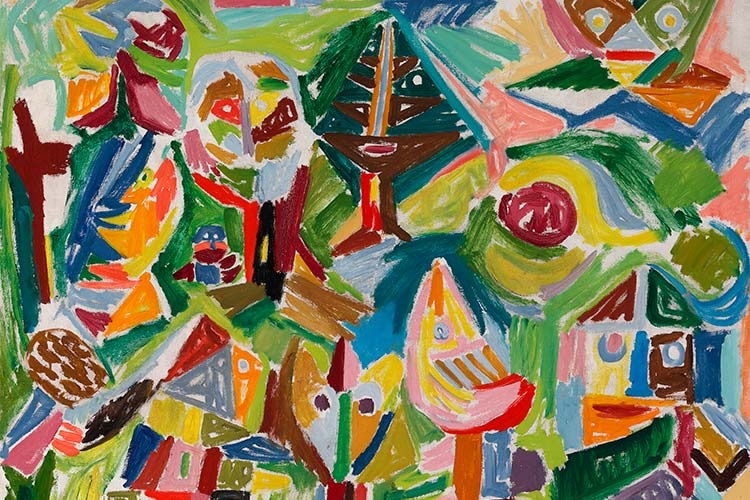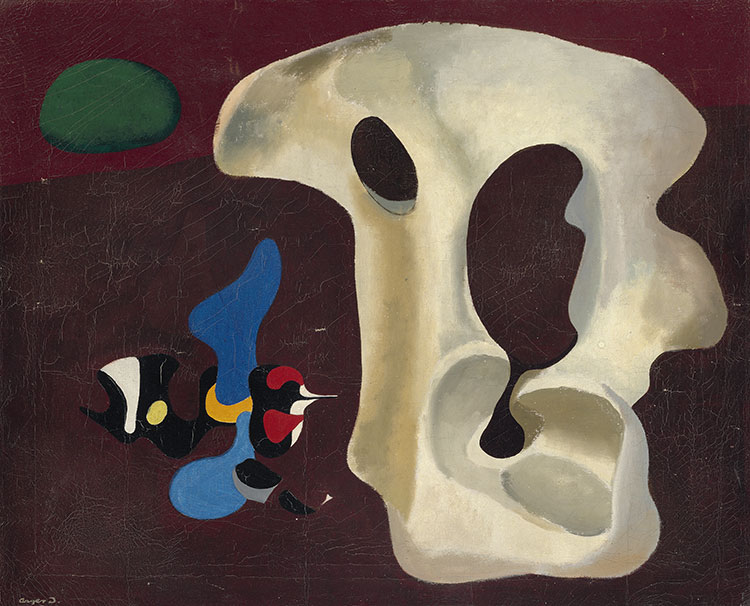Asger Jorn’s Liberation Painting
75 years ago, a Danish radio announcer could present the happy news that the German troops occupying Denmark had surrendered, and the country was once again a free nation. It's not hard to imagine the joy felt on that bright spring evening of 4 May, and we mark the occasion with a firecracker of a painting created by Asger Jorn in 1945.
At this summer's auction of modern art in Copenhagen, one of the highlights is Asger Jorn’s masterpiece “Landscape in Finkidong”. With its clear colours, myriad of figures, lush landscape and glorious sun, the work appears as a life-affirming image of liberation – as if it was an attempt to encapsulate the euphoric mood of the moment. The title “Landscape in Finkidong” refers in the usual "Jornish" way to a fictional place and emphasizes his intention of not providing clear interpretative solutions for the viewer.
Parisian Avantgarde and Nordic Folk Art
The unbridled summer image belongs to Jorn's early period before the founding of CoBrA, at a time where he created picturesque connections between his impressions from the progressive art scene in 1930s Paris and the Danish landscape tradition and Nordic folk art. It is also a period where, in collaboration with a number of artists, poets and other aesthetes, Jorn published the culturally and socially critical wartime journal "Helhesten" (The Hell Horse). With Modernist art and articles on everything from African masks to jazz music, the journal was both a humorous and scathing provocation of the German occupation force. The offered painting "Landscape in Finkidong" is related to one of Jorn’s most important works of the period, "Guganaga", which today belongs to the ARoS art museum and was the first painting that Jorn completed after the liberation of Denmark.
A True Transformational Image
In his book “Asger Jorns kunst” (The Art of Asger Jorn) from 2014, author and intellectual historian Lars Morell uses the concept of “transformational images” as a very useful approach to Jorn's art. It is a metaphor that makes perfect sense, also when it comes to “Landscape in Finkidong”. The painting is literally a kaleidoscope, where individual parts and details change appearance in front of the viewer and at the same time become part of different figurations. Jorn himself wrote about pictorial ambiguity in connection with his stay in Saxnäs in northern Sweden in the summer of 1946. That the artist himself regarded the composition as significant and successful is supported by the fact that the motif also exists in a lithographic version from 1944 – printed in only 40 copies, though not with the painting's title "Landscape in Finkidong" – but rather "Midsummer Games".
Additional Works by Jorn and an Unknown Side of the Artist
At the auction we can present two other works by Jorn – one with surrealist undertones from the 1930s period in Paris entitled "Le Bourdon" and one of his characteristic “Aganak” paintings from 1951. We have also included a more unknown part of Jorn's oeuvre with a bangle of silver-plated brass. From the early 1930s and onwards, he created personalized jewellery for the women in his life, which included several wives, daughters, sisters and lovers, and here he also found his inspiration in avant-garde art and ritual masks.
|
|
|
|
For further information, please contact:
Niels Raben: +45 8818 1181 · nr@bruun-rasmussen.dk
Niels Boe Hauggaard: +45 8818 1182 · nbh@bruun-rasmussen.dk
Kathrine Eriksen: +45 8818 1184 · ke@bruun-rasmussen.dk
Victor Svane Nielsen: +45 8818 1125 · vsn@bruun-rasmussen.dk
Stephanie Ingemann-Petersen: +45 8818 1185 · sip@bruun-rasmussen.dk


